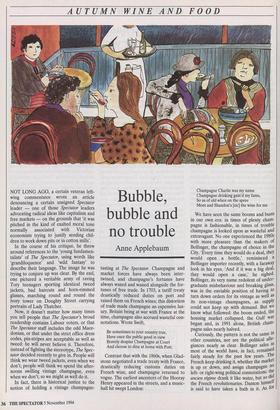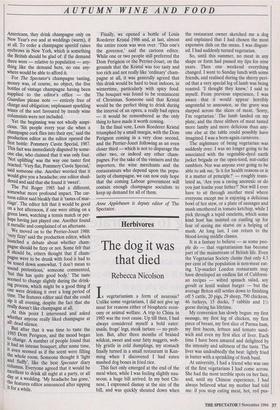AUTUMN WINE AND FOOD
Bubble, bubble and no trouble
Anne Applebaum
NOT LONG AGO, a certain veteran left- wing commentator wrote an article denouncing a certain unsigned Spectator leader — one of those Spectator leaders advocating radical ideas like capitalism and free markets — on the grounds that 'it was pitched in the kind of exalted moral tone normally associated with Victorian economists trying to justify sending chil- dren to work down pits or in cotton mills'.
In the course of his critique, he threw around references to the 'young fundamen- talists' of The Spectator, using words like `grandiloquence' and 'wild fantasy' to describe their language. The image he was trying to conjure up was clear. By the end, one pictured a veritable army of raving Tory teenagers sporting identical tweed jackets, bad haircuts and horn-rimmed glasses, marching round and round the ivory tower on Doughty Street carrying portraits of Lady Thatcher.
Now, it doesn't matter how many times you tell people that The Spectator's broad readership contains Labour voters, or that The Spectator staff includes the odd Mace- donian, or that under the strict office dress codes, pin-stripes are acceptable as well as tweed: he will never believe it. Therefore, instead of fighting the stereotype, The Spec- tator decided recently to give in. People will think we wear tweed jackets, even when we don't; people will think we spend the after- noons swilling vintage champagne, even when we don't; so we might as well do it.
In fact, there is historical justice to the notion of holding a vintage champagne- tasting at The Spectator. Champagne and market forces have always been inter- twined, and champagne's fortunes have always waxed and waned alongside the for- tunes of free trade. In 1703, a tariff treaty drastically reduced duties on port and raised them on French wines; this distortion of trade made champagne an expensive lux- ury. Britain being at war with France at the time, champagne also accrued wasteful con- notations. Wrote Swift,
Be sometimes to your country true, Have once the public good in view Bravely despise Champagne at Court And choose to dine at home with Port.
Contrast that with the 1860s, when Glad- stone negotiated a trade treaty with France, drastically reducing customs duties on French wine, and champagne returned to vogue. The earliest ancestors of the Hooray Henry appeared in the streets, and a music- hall hit swept London:
Champagne Charlie was my name Champagne drinking gain'd my fame, So as of old when on the spree Moet and Shandon's [sic] the wine for me
We have seen the same booms and busts in our own era: in times of plenty cham- pagne is fashionable, in times of trouble champagne is looked upon as wasteful and extravagant. No one experienced the 1980s with more pleasure than the makers of Bollinger, the champagne of choice in the City. 'Every time they would do a deal, they would open a bottle,' reminisced a Bollinger importer recently, with a faraway look in his eyes. And if it was a big deal, they would open a case,' he sighed. Bollinger, its very name redolent of under- graduate misbehaviour and breaking glass, was in the enviable position of having to turn down orders for its vintage as well as its non-vintage champagnes, as supplY could not keep up with demand. But we know what followed: the boom ended, the housing market collapsed, the Gulf war began and, in 1991 alone, British cham- pagne sales nearly halved. Curiously, the pattern is not the same in other countries, nor are the political alle- giances nearly as clear. Bollinger sales in most of the world have, in fact, remained fairly steady for the past few years. The French keep drinking it, whether the market is up or down, and assign champagne no left- or right-wing political connotations: the ancien regime drank it like water, but so did the French revolutionaries. Danton himself is said to have taken a bath in it. As for
AUTUMN WINE AND FOOD
Americans, they drink champagne only on New Year's eve and at weddings (warm), if at all. To order a champagne aperitif raises eyebrows in New York, which is something the British should be glad of: if the demand there were — relative to population — any- thing like the demand here, no one any- where would be able to afford it.
For The Spectator's champagne tasting, money was, of course, no object, the five bottles of vintage champagne having been supplied to the editor's office — the Guardian please note — entirely free of charge and obligation; unpleasant sparkling wines of the sort favoured by trendy wine columnists were not included.
Yet the beginning was not wholly auspi- cious. 'Six people every year die when a champagne cork flies into their eye,' said the production editor as the editor opened the first bottle: Pommery Cuvez Special, 1987. This fact was immediately disputed by some- one else, who claimed that it was only four. Not uplifting' was the way one taster first reacted: 'Very flat, Pommery Cuvee Special,' said someone else. Another worried that it would give you a headache; one editor shud- dered and said that she found it 'sweet'.
The Pol Roger 1985 had a different, somewhat more profound impact. The car- toon editor said bleakly that it 'tastes of mar- riage'. The editor felt that it would be good on a hot afternoon, if one were sitting on a green lawn, watching a tennis match or per- haps having just played one. Another found it metallic and complained of an aftertaste. We moved on to the Perrier-Jouet 1988: `very fizzy' said the production editor, which launched a debate about whether cham- pagne should be fizzy or not. Some felt that it should be, others thought that if cham- pagne were to be drunk with food it had to be toned down somewhat. 'I don't mean to sound pretentious,' someone commented, but this has quite good body.' The taste seemed to change slightly during the drink- ing process, which might be a good thing if one were drinking it over a long period of time. The features editor said that she could sin it all evening, despite the fact that she really doesn't like champagne at all. At this point I intervened and asked whether anyone really liked champagne at all: dead silence. But after that it was time to taste the 1985 Dom Perignon, and the mood began to change. A number of people found that it had an intense bouquet; after some time, it even seemed as if the scent were filling the whole room. Someone thought it 'light and fluffy', like the best Spectator diary columns. Everyone agreed that it would be excellent to drink all night at a party, or all day at a wedding. 'My headache has gone,' the features editor announced after sipping it for a while. Finally, we opened a bottle of Louis Roederer Kristal 1986 and, at last, almost the entire room was won over. 'This one's the governor,' said the cartoon editor. While one or two people still preferred the Dom Perignon or the Perrier-Jouet, on the grounds that the Kristal was too tasty and too rich and not really like 'ordinary' cham- pagne at all, it was generally agreed that this drink would be hard to beat indoors, in wintertime, particularly with spicy food. The bouquet was found to be reminiscent of Christmas. Someone said that Kristal would be the perfect thing to drink during the interval of an opera, a really bad opera — it would be remembered as the only thing to have made it worth coming.
In the final vote, Louis Roederer Kristal triumphed by a small margin, with the Dom Perignon coming in a very close second, and the Perrier-Jouet following as an even closer third — which is not to disparage the other two, or indeed any other cham- pagnes. For the sake of the vintners and the importers, the wine merchants and the restaurateurs who depend upon the popu- larity of champagne, we can now only hope that the coming Labour government will contain enough champagne socialists to keep up demand for all of them.
Anne Applebaum is deputy editor of The Spectator.











































































 Previous page
Previous page